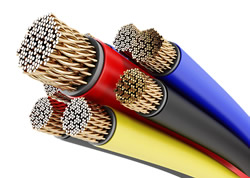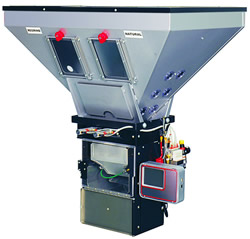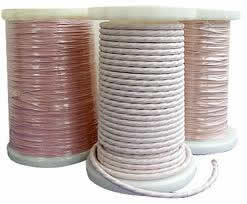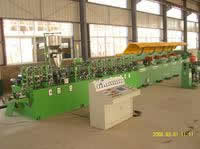Gravimetric Blender Payback for Wire & Cable Coaters




Companies in the wire and cable industry are discovering that gravimetric blenders are the most effective means available to control the critical costs of raw materials for insulation and jacketing, including both compounds and colorants. Precise and consistent material management of jacketing materials are the factors that allow fast payback for wire and cable coaters.
A gravimetric blender can be mounted directly over the throat of an extruder and the blender controls raw material metering by weighing each recipe batch. Recipe ratios can be varied from 0.01 to 100% with simple, easy-to-use controls. In operation, the blender sequentially dispenses all ingredients, in their targeted recipe proportions, from separate hopper bins into a weigh chamber. From there the batch falls into a mixing chamber and is then fed directly into the processing machine. In subsequent batches, small corrections are made automatically.
The key benefits provided by gravimetric blenders are:
- Reduced material consumption
Precise control over the metering of all materials into the extruder, including compound and costly colorants and additives – reduces waste. Blender self-adjustment compensates for variations in extrusion rate or bulk density, so the blender maintains batch accuracy within ±0.1%. This renders unnecessary such wasteful practices as “over-coloring” to compensate for process variations or for the unreliability of conventional feeding equipment.
The resulting savings in material costs alone can enable a manufacturer to achieve payback on the cost of a gravimetric blender in less than twelve months, and for high-throughput operations, the payback time can be considerably shorter.
- Gain in operational efficiency
Compounding raw materials right at the extruder frees manufacturers from the cost premium and inventory commitment associated with using pre-colored compounds, or from the labor and batch variations of pre-mixing raw materials off-line. The operational streamlining made possible is particularly valuable for companies that supply customers on a just-in-time basis.
- Improved quality assurance and accountability
In addition to the quality-control benefits of maintaining recipe consistency throughout a job run and from one run to the next, the precise control over ingredients is particularly important for manufacturers serving high-specification markets. The formulation data generated for each batch by the blender controller is readily accessible for meeting documentation requirements such as those for ISO-9000 operations.
- Expanded factory automation
The wealth of data generated by the blender controller has even broader potential for manufacturers looking to establish a system of plant-wide (or even multi-plant) monitoring and control. Various software can be used for networking blenders and even for linking blenders with other machinery, translating between their different controller languages.
Optimizing Electrical Performance through Color Control
Color-coding of wire is both a blessing and a curse. The color-coding is necessary for product identity but too much color can interfere with or degrade electrical performance. In the downstream test of dielectric integrity, commonly performed on wire-coating lines, insulation with too much colorant or erratic color dispersion will fail the test by “sparking-out”. By increasing the accuracy and consistency of color dosing, a good gravimetric blender enables wire and cable manufacturers to reduce colorant levels, not only to save costs but to enhance the electrical performance of the product in the spark test and in subsequent end use.



